engine TOYOTA FR-S 2013 Owners Manual (in English)
[x] Cancel search | Manufacturer: TOYOTA, Model Year: 2013, Model line: FR-S, Model: TOYOTA FR-S 2013Pages: 412, PDF Size: 5.3 MB
Page 2 of 412
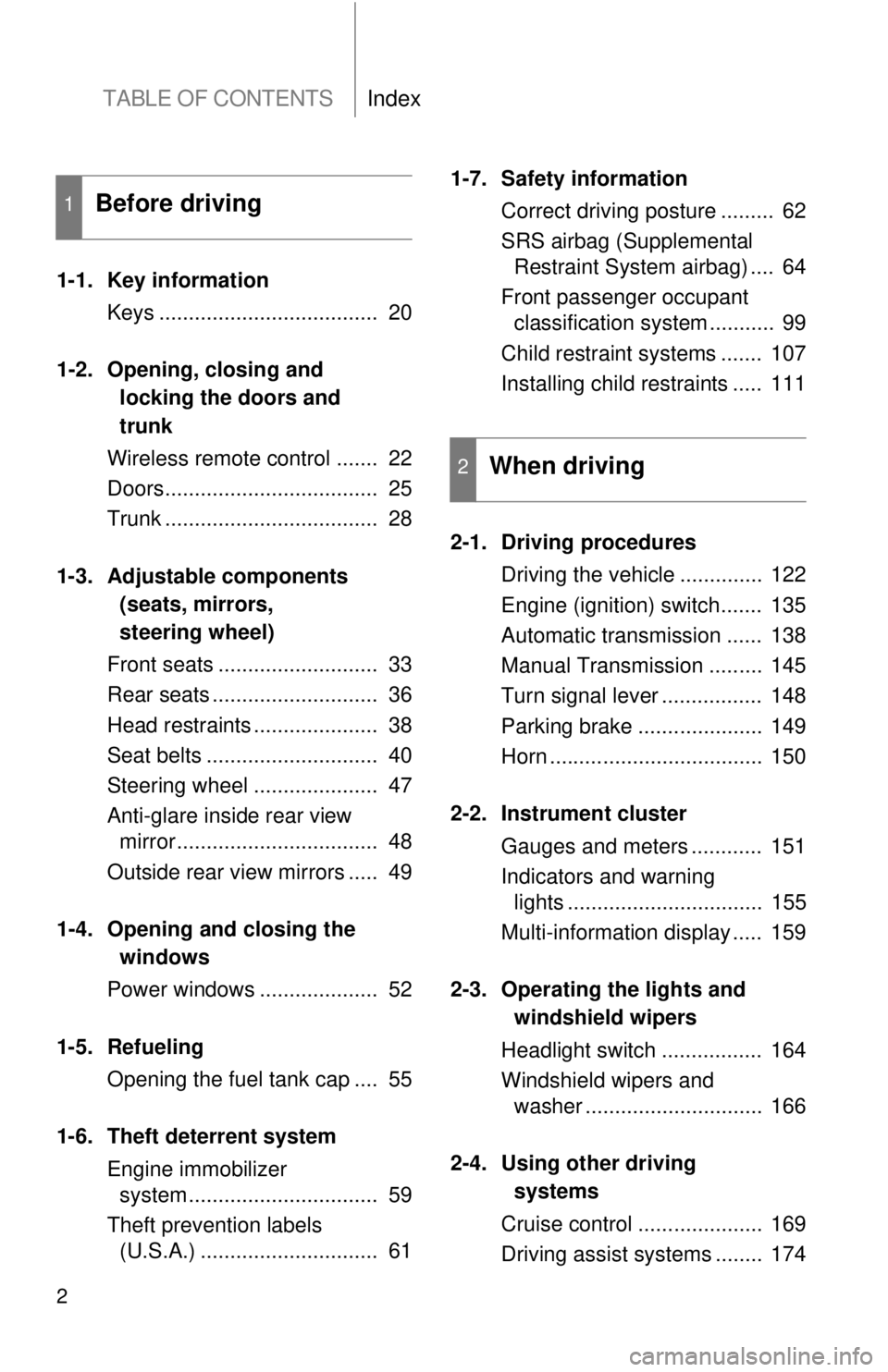
TABLE OF CONTENTSIndex
2
1-1. Key informationKeys ..................................... 20
1-2. Opening, closing and locking the doors and
trunk
Wireless remote control ....... 22
Doors.................................... 25
Trunk .................................... 28
1-3. Adjustable components (seats, mirrors,
steering wheel)
Front seats ........................... 33
Rear seats ............................ 36
Head restraints ..................... 38
Seat belts ............................. 40
Steering wheel ..................... 47
Anti-glare inside rear view mirror .................................. 48
Outside rear view mirrors ..... 49
1-4. Opening and closing the windows
Power windows .................... 52
1-5. Refueling Opening the fuel tank cap .... 55
1-6. Theft deterrent system Engine immobilizer system ................................ 59
Theft prevention labels (U.S.A.) .............................. 61 1-7. Safety information
Correct driving posture ......... 62
SRS airbag (Supplemental Restraint System airbag) .... 64
Front passenger occupant classification system ........... 99
Child restraint systems ....... 107
Installing child restraints ..... 111
2-1. Driving procedures Driving the vehicle .............. 122
Engine (ignition) switch....... 135
Automatic transmission ...... 138
Manual Transmission ......... 145
Turn signal lever ................. 148
Parking brake ..................... 149
Horn .................................... 150
2-2. Instrument cluster Gauges and meters ............ 151
Indicators and warning lights ................................. 155
Multi-information display ..... 159
2-3. Operating the lights and windshield wipers
Headlight switch ................. 164
Windshield wipers and washer .............................. 166
2-4. Using other driving systems
Cruise control ..................... 169
Driving assist systems ........ 174
1Before driving
2When driving
Page 4 of 412
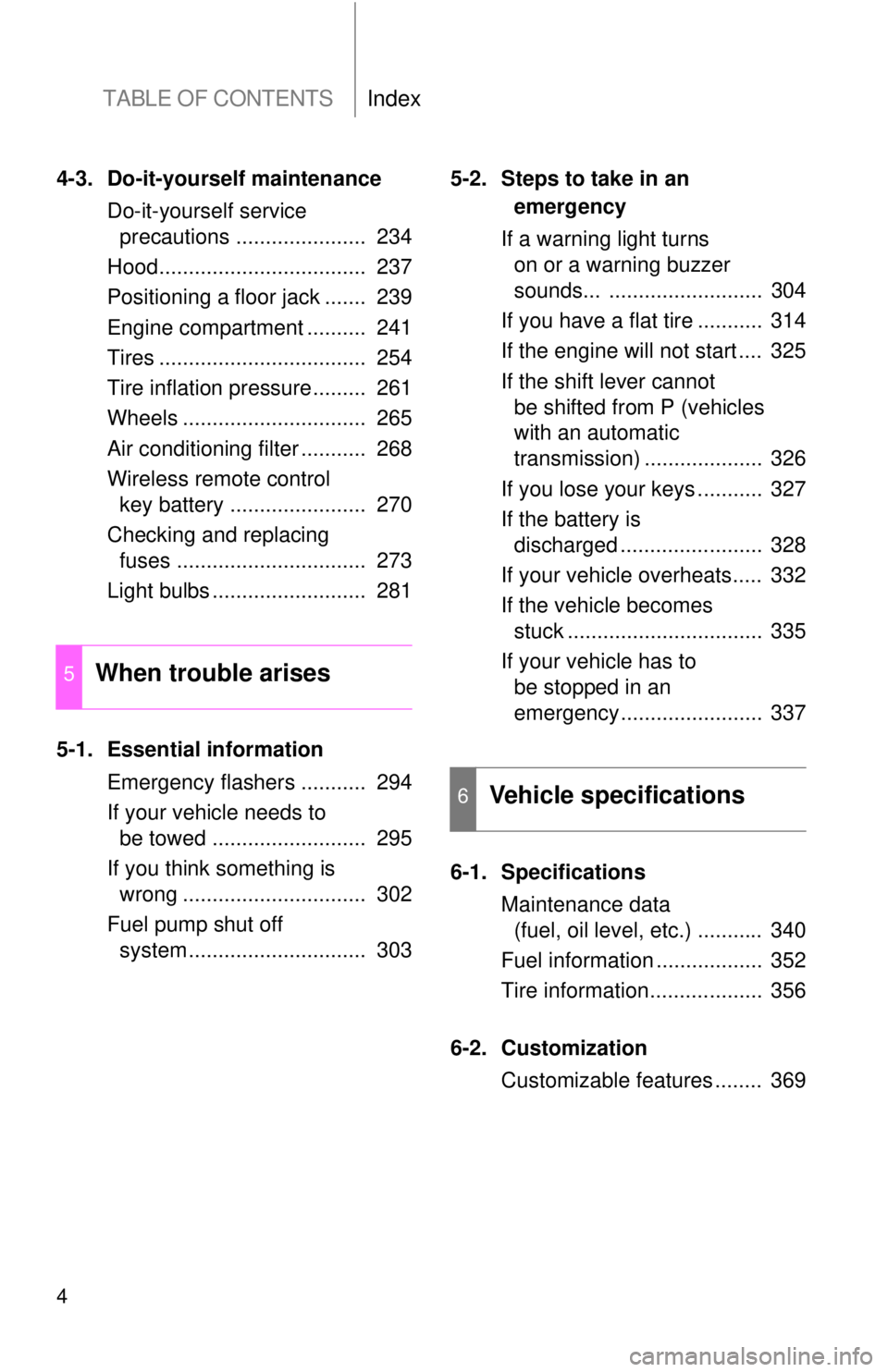
TABLE OF CONTENTSIndex
4
4-3. Do-it-yourself maintenanceDo-it-yourself service precautions ...................... 234
Hood................................... 237
Positioning a floor jack ....... 239
Engine compartment .......... 241
Tires ................................... 254
Tire inflation pressure......... 261
Wheels ............................... 265
Air conditioning filter ........... 268
Wireless remote control key battery ....................... 270
Checking and replacing fuses ................................ 273
Light bulbs .......................... 281
5-1. Essential information Emergency flashers ........... 294
If your vehicle needs to be towed .......................... 295
If you think something is wrong ............................... 302
Fuel pump shut off system .............................. 303 5-2. Steps to take in an
emergency
If a warning light turns on or a warning buzzer
sounds... .......................... 304
If you have a flat tire ........... 314
If the engine will not start .... 325
If the shift lever cannot be shifted from P (vehicles
with an automatic
transmission) .................... 326
If you lose your keys ........... 327
If the battery is discharged ........................ 328
If your vehicle overheats..... 332
If the vehicle becomes stuck ................................. 335
If your vehicle has to be stopped in an
emergency........................ 337
6-1. Specifications Maintenance data (fuel, oil level, etc.) ........... 340
Fuel information .................. 352
Tire information................... 356
6-2. Customization Customizable features ........ 369
5When trouble arises
6Vehicle specifications
Page 13 of 412
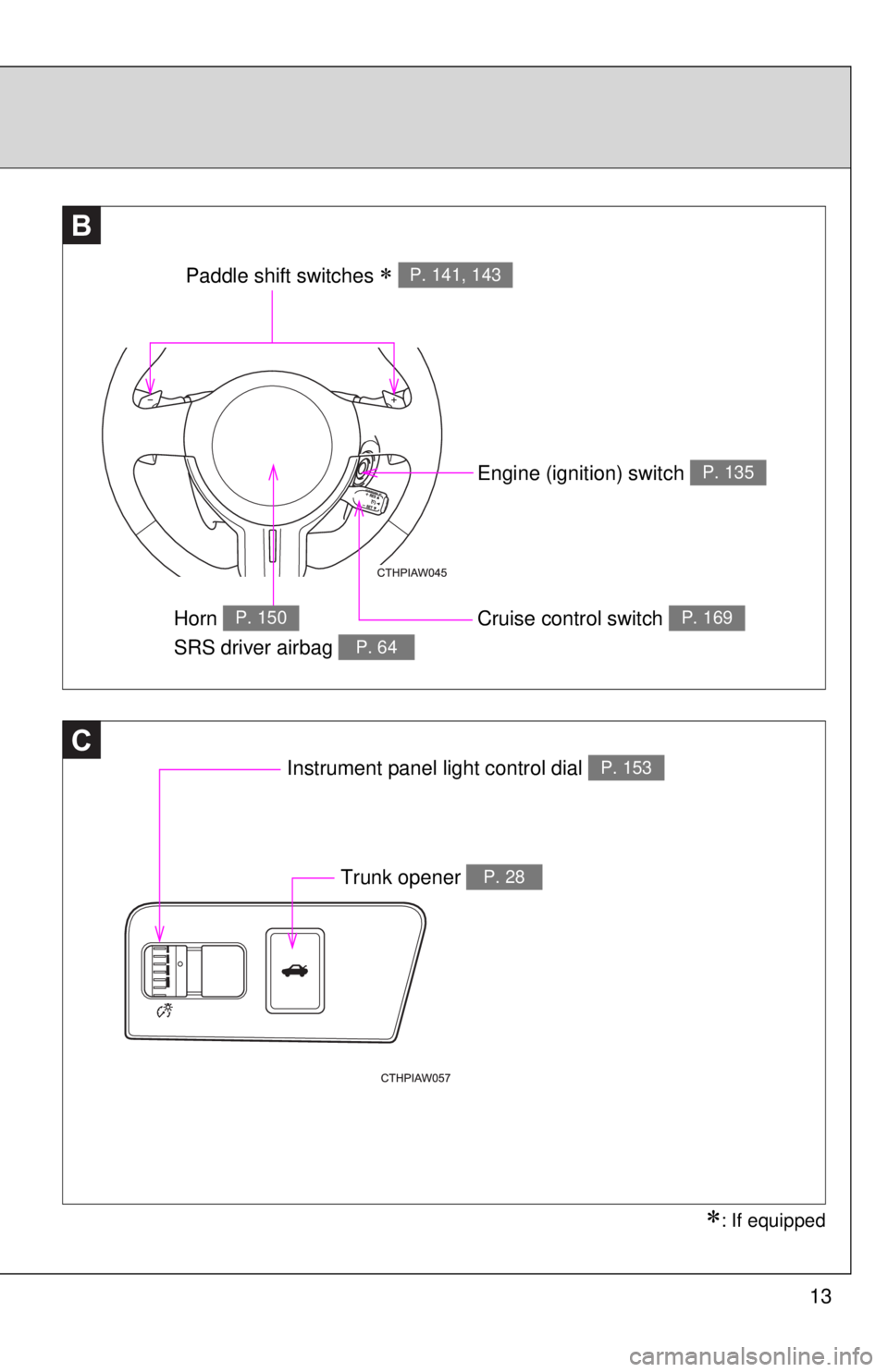
13
C
BB
Paddle shift switches P. 141, 143
Engine (ignition) switch P. 135
Cruise control switch P. 169Horn
SRS driver airbag P. 150
P. 64
Instrument panel light control dial P. 153
Trunk opener P. 28
: If equipped
Page 14 of 412

14
For your information
Main Owner’s Manual
Please note that this manual applies to all models and explains all equip-
ment, including options. Therefore, you may find some explanations for
equipment not installed on your vehicle.
All specifications provided in this manual are current at the time of printing.
However, because of the Scion policy of continual product improvement, we
reserve the right to make changes at any time without notice.
Depending on specifications, the vehicle shown in the illustration may differ
from your vehicle in terms of color and equipment.
Noise from under vehicle after turning off the engine
Approximately five hours after the engine is turned off, you may hear sound
coming from under the vehicle for several minutes. This is the sound of a fuel
evaporation leakage check and, it does not indicate a malfunction.
Accessories, spare parts and modification of your Scion
A wide variety of non-genuine spare parts and accessories for Scion vehicles
are currently available in the market. You should know that Scion does not
warrant these products and is not responsible for their performance, repair,
or replacement, or for any damage they may cause to, or adverse effect they
may have on, your Scion vehicle.
This vehicle should not be modified with non-genuine Scion products. Modifi-
cation with non-genuine Scion products could affect its performance, safety
or durability, and may even violate governmental regulations. In addition,
damage or performance problems resulting from the modification may not be
covered under warranty.
Page 19 of 412
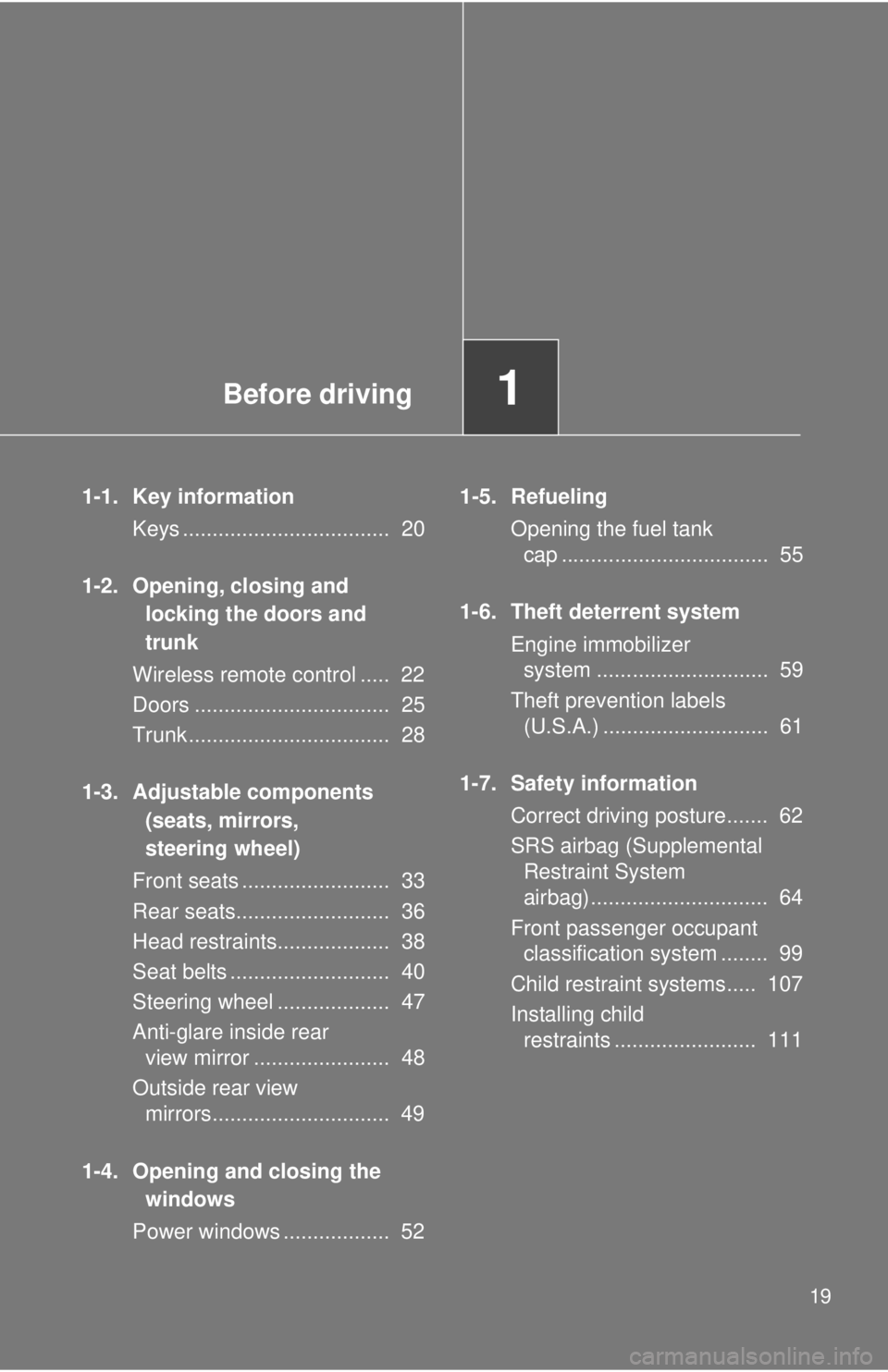
Before driving1
19
1-1. Key informationKeys ................................... 20
1-2. Opening, closing and locking the doors and
trunk
Wireless remote control ..... 22
Doors ................................. 25
Trunk .................................. 28
1-3. Adjustable components (seats, mirrors,
steering wheel)
Front seats ......................... 33
Rear seats.......................... 36
Head restraints................... 38
Seat belts ........................... 40
Steering wheel ................... 47
Anti-glare inside rear view mirror ....................... 48
Outside rear view mirrors.............................. 49
1-4. Opening and closing the windows
Power windows .................. 52 1-5. Refueling
Opening the fuel tank cap ................................... 55
1-6. Theft deterrent system Engine immobilizer system ............................. 59
Theft prevention labels (U.S.A.) ............................ 61
1-7. Safety information Correct driving posture....... 62
SRS airbag (Supplemental Restraint System
airbag).............................. 64
Front passenger occupant classification system ........ 99
Child restraint systems..... 107
Installing child restraints ........................ 111
Page 50 of 412
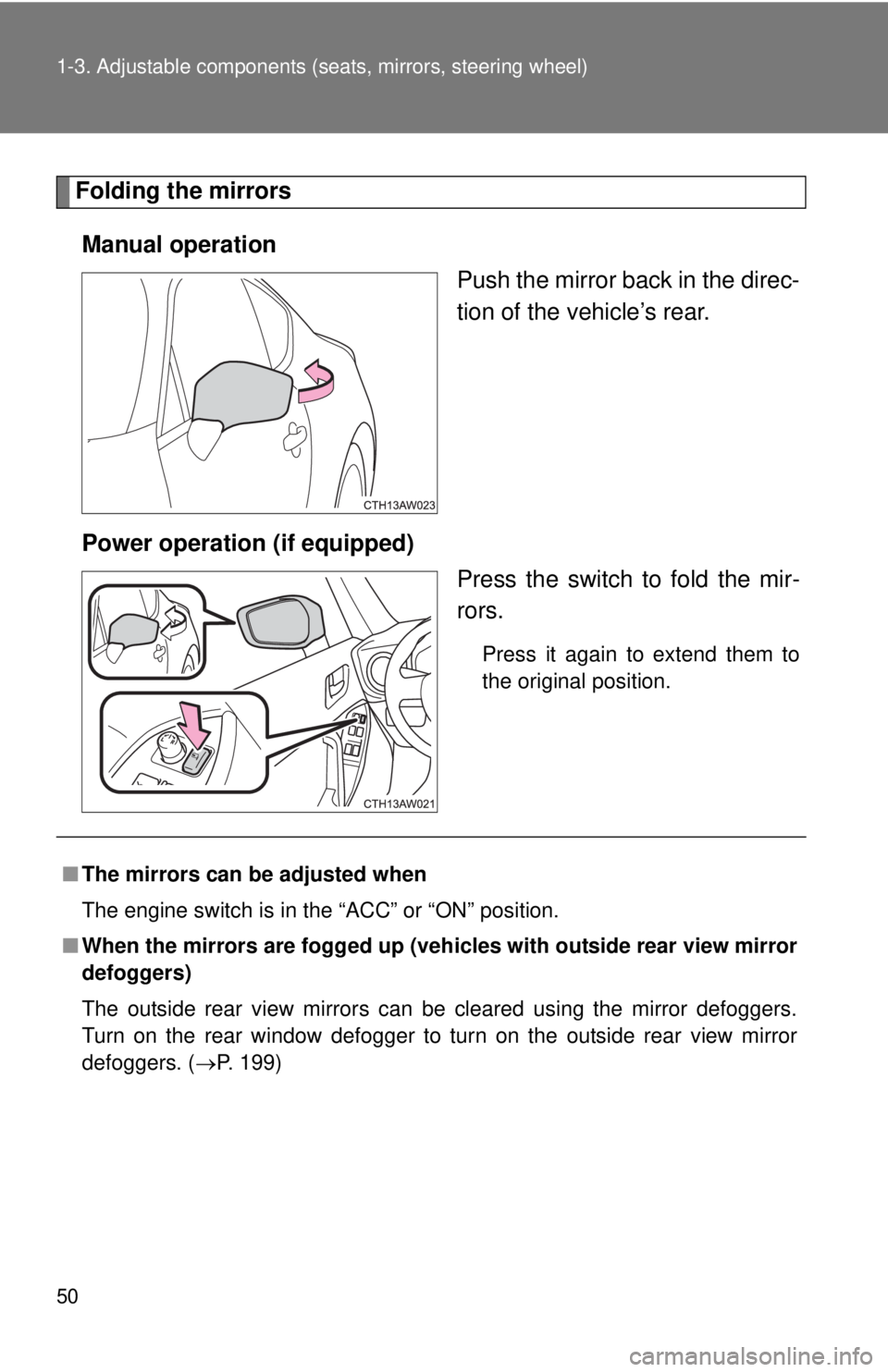
50 1-3. Adjustable components (seats, mirrors, steering wheel)
Folding the mirrors
Manual operation Push the mirror back in the direc-
tion of the vehicle’s rear.
Power operation (if equipped) Press the switch to fold the mir-
rors.
Press it again to extend them to
the original position.
■The mirrors can be adjusted when
The engine switch is in the “ACC” or “ON” position.
■ When the mirrors are fogged up (veh icles with outside rear view mirror
defoggers)
The outside rear view mirrors can be cleared using the mirror defoggers.
Turn on the rear window defogger to turn on the outside rear view mirror
defoggers. ( P. 199)
Page 53 of 412
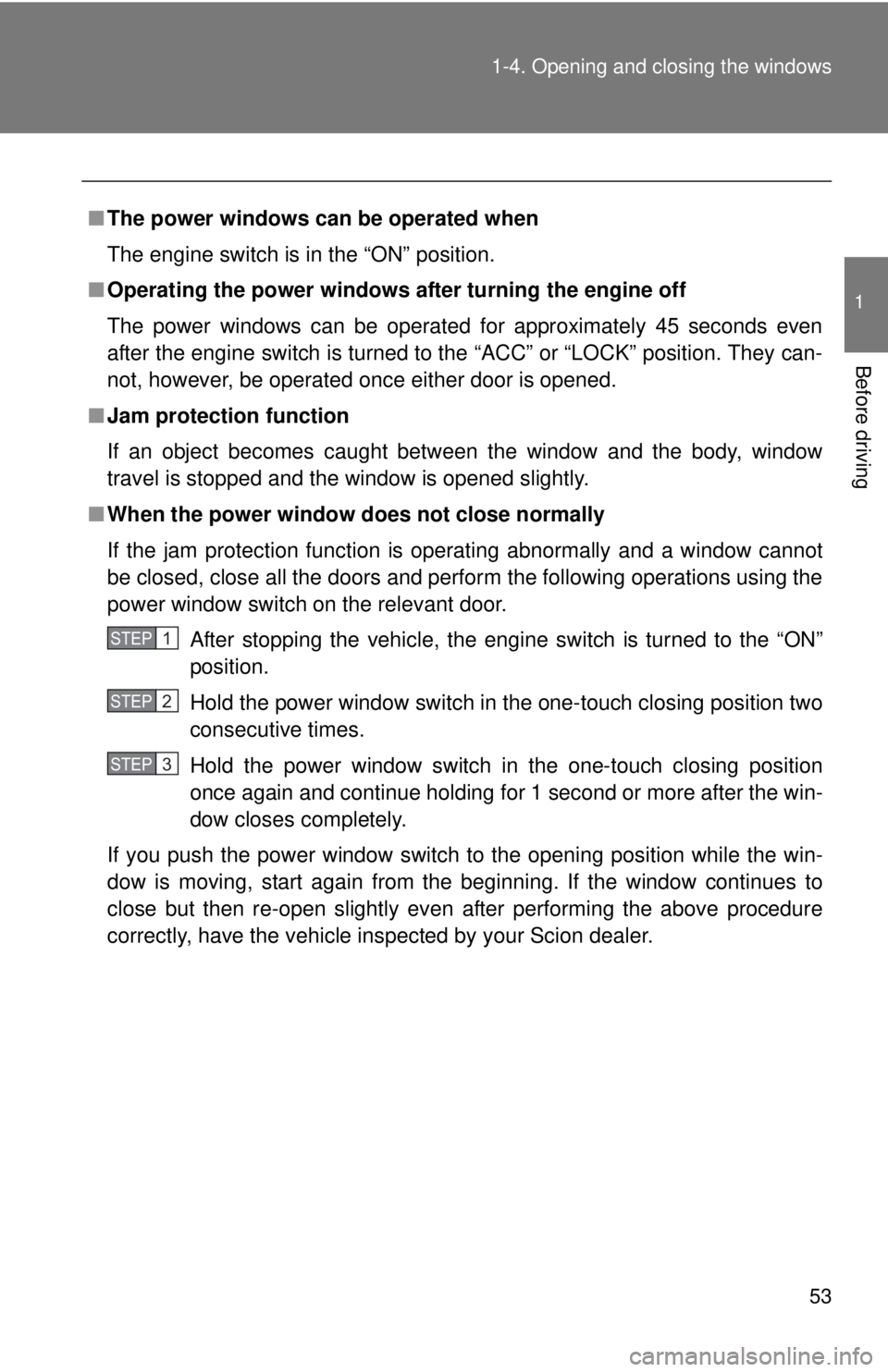
53
1-4. Opening and closing the windows
1
Before driving
■
The power windows can be operated when
The engine switch is in the “ON” position.
■ Operating the power windows after turning the engine off
The power windows can be operated for approximately 45 seconds even
after the engine switch is turned to the “ACC” or “LOCK” position. They can-
not, however, be operated once either door is opened.
■ Jam protection function
If an object becomes caught between the window and the body, window
travel is stopped and the window is opened slightly.
■ When the power window does not close normally
If the jam protection function is operating abnormally and a window cannot
be closed, close all the doors and perform the following operations using the
power window switch on the relevant door.
After stopping the vehicle, the engine switch is turned to the “ON”
position.
Hold the power window switch in the one-touch closing position two
consecutive times.
Hold the power window switch in the one-touch closing position
once again and continue holding for 1 second or more after the win-
dow closes completely.
If you push the power window switch to the opening position while the win-
dow is moving, start again from the beginning. If the window continues to
close but then re-open slightly even after performing the above procedure
correctly, have the vehicle inspected by your Scion dealer.
STEP 1
STEP 2
STEP 3
Page 55 of 412
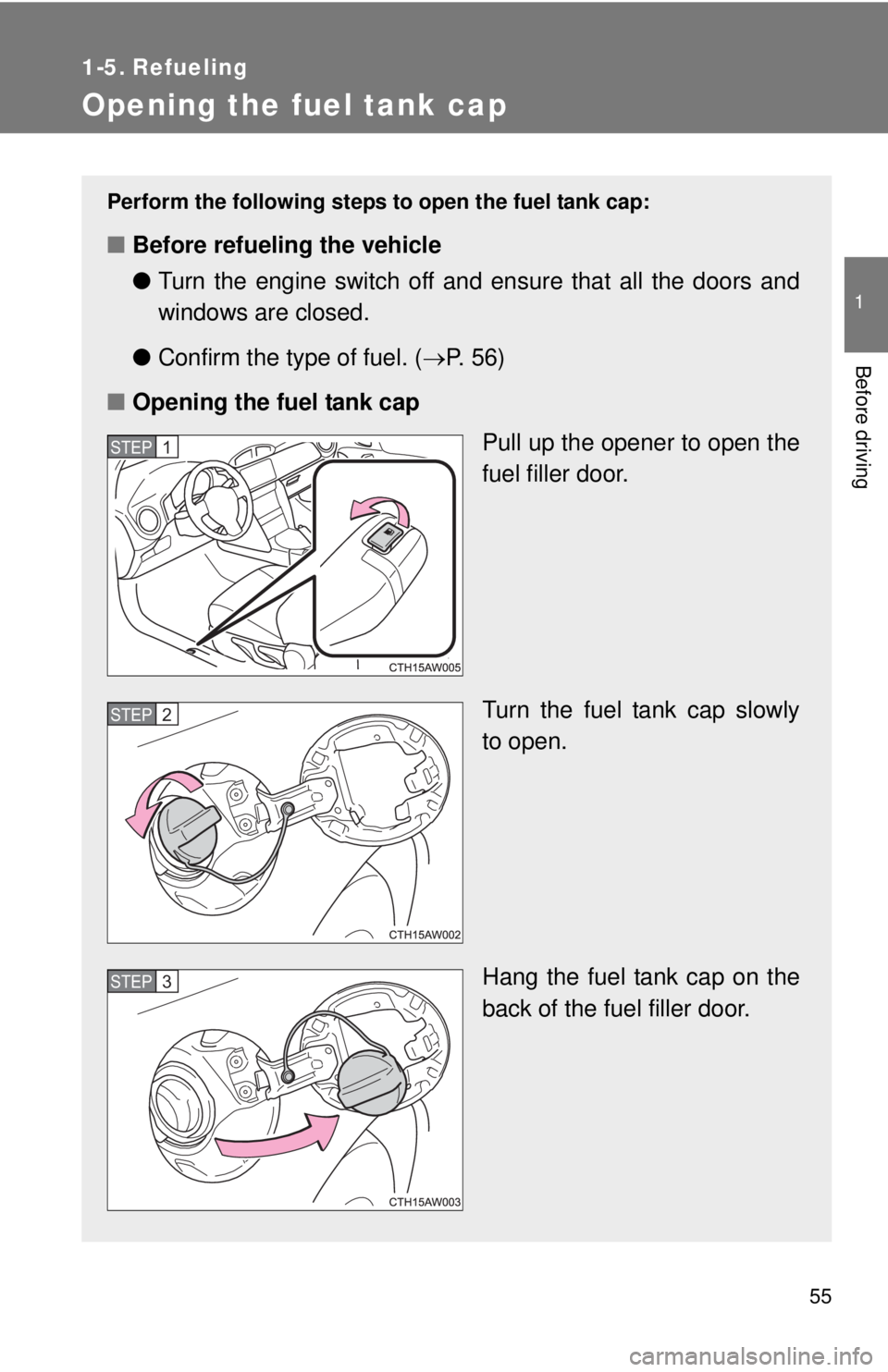
55
1
Before driving
1-5. Refueling
Opening the fuel tank cap
Perform the following steps to open the fuel tank cap:
■Before refueling the vehicle
●Turn the engine switch off and ensure that all the doors and
windows are closed.
● Confirm the type of fuel. ( P. 5 6 )
■ Opening the fuel tank cap
Pull up the opener to open the
fuel filler door.
Turn the fuel tank cap slowly
to open.
Hang the fuel tank cap on the
back of the fuel filler door.
STEP 1
STEP 2
STEP 3
Page 56 of 412
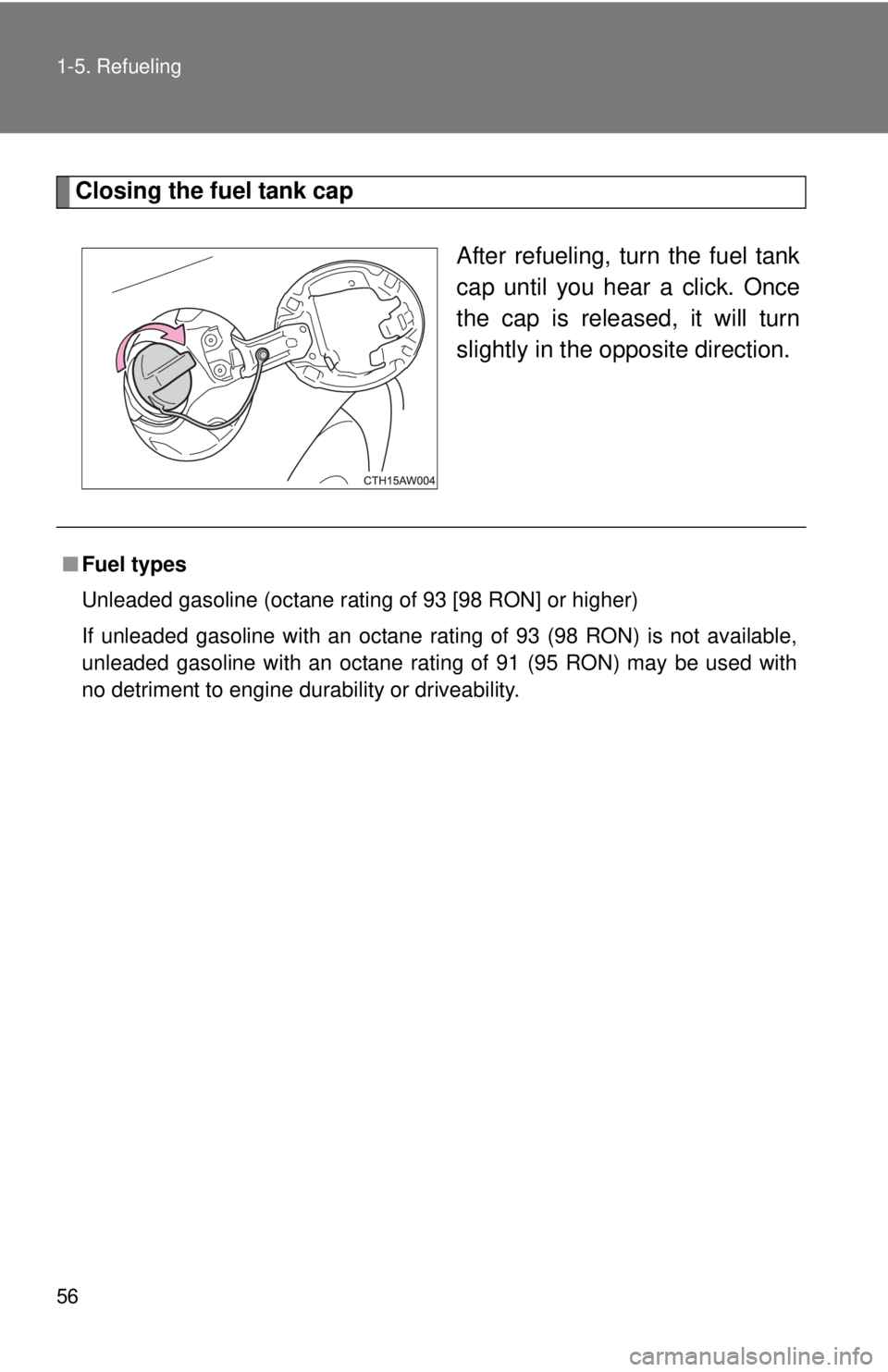
56 1-5. Refueling
Closing the fuel tank capAfter refueling, turn the fuel tank
cap until you hear a click. Once
the cap is released, it will turn
slightly in the opposite direction.
■Fuel types
Unleaded gasoline (octane rating of 93 [98 RON] or higher)
If unleaded gasoline with an octane rating of 93 (98 RON) is not available,
unleaded gasoline with an octane rating of 91 (95 RON) may be used with
no detriment to engine durability or driveability.
Page 58 of 412
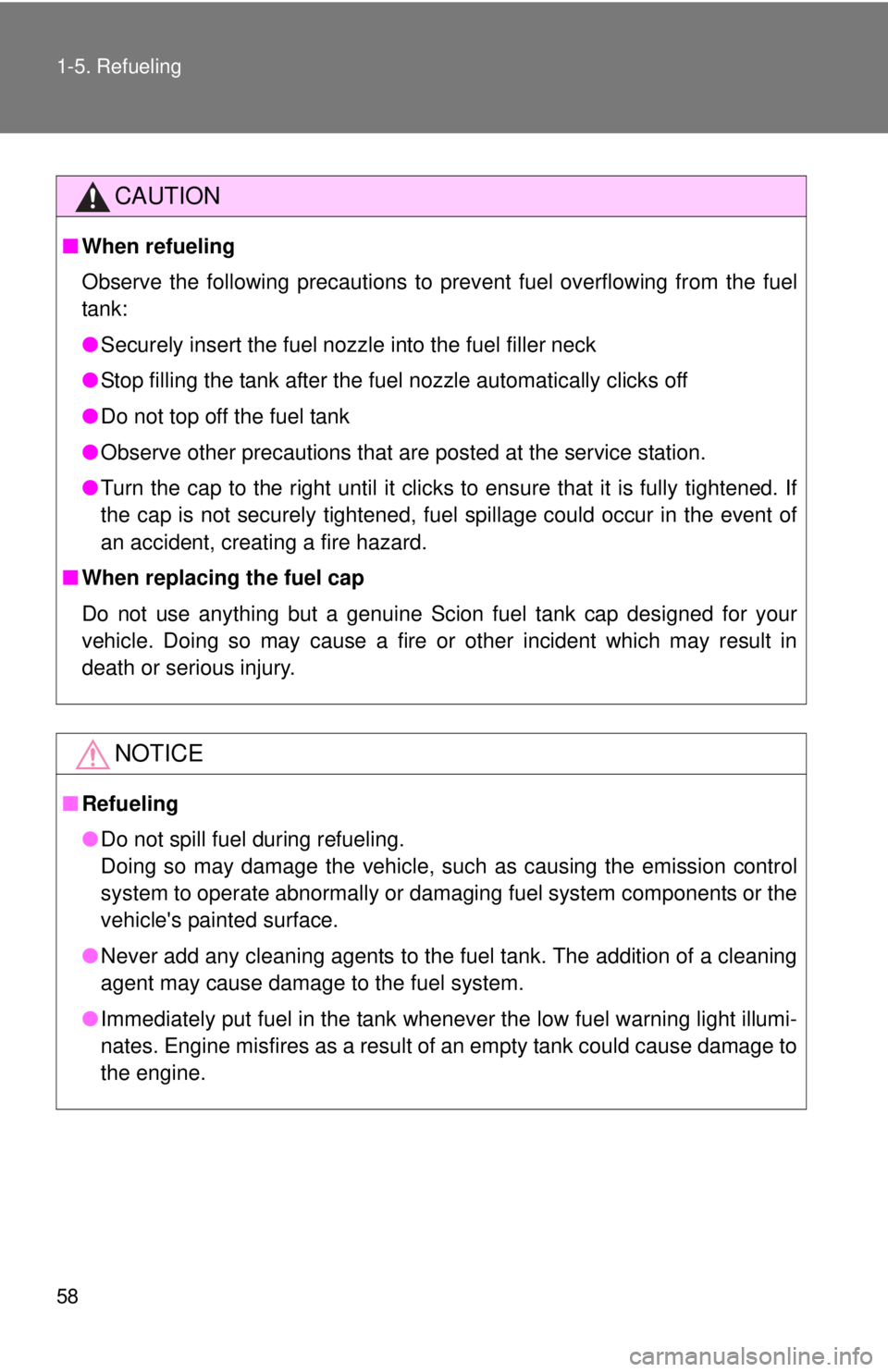
58 1-5. Refueling
CAUTION
■When refueling
Observe the following precautions to prevent fuel overflowing from the fuel
tank:
●Securely insert the fuel nozzle into the fuel filler neck
● Stop filling the tank after the fuel nozzle automatically clicks off
● Do not top off the fuel tank
● Observe other precautions that are posted at the service station.
● Turn the cap to the right until it clicks to ensure that it is fully tightened. If
the cap is not securely tightened, fuel spillage could occur in the event of
an accident, creating a fire hazard.
■ When replacing the fuel cap
Do not use anything but a genuine Scion fuel tank cap designed for your
vehicle. Doing so may cause a fire or other incident which may result in
death or serious injury.
NOTICE
■Refueling
●Do not spill fuel during refueling.
Doing so may damage the vehicle, such as causing the emission control
system to operate abnormally or damaging fuel system components or the
vehicle's painted surface.
● Never add any cleaning agents to the fuel tank. The addition of a cleaning
agent may cause damage to the fuel system.
● Immediately put fuel in the tank whenever the low fuel warning light illumi-
nates. Engine misfires as a result of an empty tank could cause damage to
the engine.